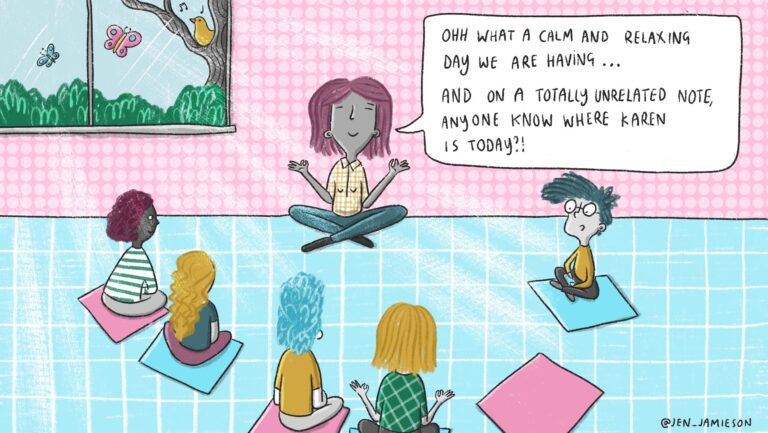Dear WeAreTeachers:
I am new to teaching older students. This year I have a lovely group of 5th graders. This is a time when students’ bodies are changing in so many ways. I have some students who are menstruating, and I want to support them. Back when I was a student, I remember feeling so uncomfortable at school when I was on my period. I was thinking of providing students with bags of period products they could use discreetly when needed rather than needing to go to the nurse or feeling embarrassed. How should I navigate this? —Not Taboo Anymore
Dear N.T.A.,
Thank you for bringing up a topic that can sometimes be tricky to talk about. You are helping to normalize talking about puberty as a healthy part of growing up. We’ve all experienced how our own bodies changed in puberty. There can be a lot of uncertainty, confusion, and embarrassment. I, for one, never had a teacher offer me support beyond a brief sex education class in middle school. Your caring and sensitive approach to building a supportive classroom culture is inspirational.
There are a lot of changes students experience in late elementary age and beyond, besides getting their periods. Many kids feel confused and are not well informed about mood swings, pimples, body odor, body hair, and changes in their body shape, too. By offering supplies and an open door to talk, you are helping students to feel more comfortable about their own unique bodies and have compassion for themselves and others.
Many states have health education standards to support teachers in talking about puberty, with content and language that focus on learning about how bodies change during puberty. Schools keep families informed about sex education classes and often materials can be reviewed. By providing some supplies in the classroom, you are helping students take care of themselves.
When setting up a self-care system of support for your students, try and be open and matter of fact. You might say, “I care about each of you. I want to support your social, academic, emotional, and physical growth. I’ve created a self-care station for us all to use when needed. Sometimes, minor situations happen and you might need a bandaid or hand sanitizer before heading to lunch. And as we grow and change, our bodies have different needs. Other times, you might realize that you forgot to wear deodorant and you’d like to use some at school. Some of you will have your periods and you might need supplies. If you would like to talk to me about the self-care station, please reach out.”
Show your students the designated area in the classroom where you store masks, hand sanitizer, deodorant, tampons/pads, wipes, and bandages. At the beginning of the year, be sure to explain the procedures around using the supplies. There are benefits to letting students get what they need on their own. You are helping them build agency and independence in caring for themselves while also lowering uncomfortable feelings that may surface about asking for what they need.
Some students and teachers will prefer a more discrete approach. If this feels better to you, then consider saying, “We have supplies in our room for all different purposes, including your physical health. Let me know if I can help you with anything. We also have a nurse that we can contact for more support.” Consider writing a note or talking to smaller groups of students (and not just cisgender girls! Remember that you may have trans and nonbinary students who menstruate), sharing that you have period products in pencil case pouches they can bring to the bathroom to use.
As humans, we ALL have challenges and changes we go through for our whole lives. Thank you for taking the initiative to set up a safe and supportive classroom space where you are proactive and talking about taboo topics such as puberty.
Dear WeAreTeachers:
Let me start by saying that I know this is a “me problem” and not a “child problem.” I would be horrified if the child had an inkling of what I’m about to say. This precious child is from India. Her backpack is very fragrant with what I’m assuming are cooking smells. I got sick as a child after eating curry, and I’m sure that’s why I have such an aversion to the smell, but I’m getting nauseous from the smell in my room. Do any of you have ideas on how to get rid of (or get used to) the smell? Doing anything that would make the child aware of my problem is not an option! —Super Duper Sensitive
Dear S.D.S.,
Your kindness and compassion really shine through in your question. It’s clear that you do not want to marginalize your student. You aren’t trying to change the student but rather you are seeking to find solutions to help you cope with your feelings of nausea. We all have sensitivities! Some people are more sensitive to light while others are more affected by noises. You are definitely impacted by smell. And even though you are not experiencing morning sickness, millions of teachers do, and they find ways to cope.
I would recommend NOT reaching out to the family or bringing up the smell of curry. We don’t really know what the aroma coming from the backpack is caused by. If you reach out to the family and tell them that you are having a reaction to the smell of curry, it could be seen as culturally insensitive. If you try ideas and are not finding any relief, then you might consider reaching out to the family. But, for now, let’s figure out some immediate possible solutions.
One thing you can try is to have students keep their backpacks outside. The fresh air will help and that might give you some immediate relief inside the classroom. If it’s not possible to leave backpacks outside, you can have the kids place their backpacks into storage boxes.
Another idea to help you feel better might be to place a couple of drops of peppermint essential oil on your clothes or a cotton ball. Peppermint has long been know for helping to calm a stomach and soothe nauseous feelings. Some people say that a dab of Vicks VapoRub under your nose works, too. Others prefer lemon, orange, or ginger oils. You can research odor sprays to help neutralize the aroma, but be careful because you don’t want to trade one strong smell for another. Many people find success with charcoal packs that are unscented and effective. Others swear by nausea relief wrist bands. Maybe one of these will give you some relief!
It’s helpful to enlist help from other staff members you trust on campus. There may be times when you need to leave your room to run to the bathroom. In that case, have someone on staff to watch your kids or step in for you for a few minutes. I’m sure you would be willing to support someone, so don’t be shy to reach out to get the support you need.
If you do eventually need to talk to the families in your class, you might say the following to all of the caregivers, “I have been suffering from severe allergies and nausea for many years and some of the students have sensitivities, too. We could use your help. Please wash your child’s backpacks. Send food in packages and containers when possible. Thanks for being a great example of compassion to your child and others.” Teaching is a really complex job and doing it while you don’t feel well is super challenging. I hope you find some relief ASAP!
Dear WeAreTeachers:
As an elementary school principal, I’m feeling frustrated with parent requests for teachers. I have a mom who believes a certain teacher is a better fit for their child. I have no complaints with the parent. I’m just cautious about setting a precedent. Is it OK to get a couple of weeks into the year and make some changes? Teachers take the time to intentionally build balanced classes. It’s so hard to know how to communicate with parents about this! I’m a parent, so I totally empathize. What are the pitfalls and positives?
—Trust Us Please
Dear T.U.P.,
Parent requests are widespread! It’s safe to say that every school has this issue. Thanks for assuming positive intentions with parents who are advocating to find a good fit for their child. As a parent of two young adults, we’ve had our challenges and inspirations over the years with teachers, so I can appreciate where parents are coming from. There’s no doubt that teachers have a great influence on children. They shape their outlook on school and life in a BIG way!
Before your school site starts accommodating the parent’s request, pause and have a discussion as a staff. The Every Student Succeeds Act (ESSA, 2015) guarantees parents’ right to be involved. The act ensures access to parent-teacher conferences, reasonable access to staff, opportunities to volunteer and observe in their child’s classroom, the chance to ask for qualifications of a child’s teachers, and more. With all that said, it’s important to have a clear message about parent requests. Most educators will advise you to NOT open that particular can of worms. Let’s think about why.
There are a great number of important variables to consider when building balanced class lists each year. It’s complex! Some factors include the number of students, gender, academic proficiency, behavior dynamics, special needs, multilingual learner support, former siblings, and more. Educators know that the art of building classes is an intentional and creative problem-solving process that involves a lot of compromises and hopefully learner-centeredness.
It’s helpful to have your administration team craft parent/caregiver communication regarding parent requests. Being proactive is helpful for teachers, kids, and caregivers! You might say something like this to parents: “Thanks for reaching out. While we are not able to allow parents to choose their child’s teacher, we do appreciate parent feedback on the characteristics of the teacher that they feel would be the best fit for their child. Please share teacher characteristics and student needs you would like us to keep in mind as we create our class lists for next year.”
It’s a nightmare when one parent’s request is honored and another parent’s isn’t. But when principals don’t allow any input from parents, that can create hostility and a lack of trust and family engagement. With or without parent requests, the talk on the playground can get negative and vicious quickly! One approach to giving parents a place to share ideas is to have surveys near the end of the year. This allows families an opportunity to provide input about the upcoming year’s teacher. No matter what, we can still handle the situation in a compassionate and proactive way.
We also know that parent requests can affect the culture of the staff. A competitive, resentful staff will not create the best learning conditions for kids. Teachers need to have buy-in and a voice in the class-building process in order to promote empowerment and true collaboration.
Maintaining a student-centered approach is key. Even once classes have been designed, there may be issues that come up that require a change in teacher. Stay open, flexible, and make decisions in a collaborative way to do the best possible for every single child every day.
Dear WeAreTeachers:
I’m a first-year teacher, and I teach 2nd grade reading and writing. I need help with time management. It feels like I can never fully get through my lessons and teach what I need to. I’m rushing and stopping all of the meaningful conversations. It feels awful! I don’t even think kids are learning very much. How can I fit it all in in a way that’s good for kids? Any advice? —Cramming It All In
Dear C.I.A.I,
Congratulations on all the hard work it took to become a teacher! I seriously have never met a teacher who doesn’t struggle with time management. And your concern about student learning is universal! By engaging in reflection, progress monitoring, and deliberate planning, your confidence will blossom and your students’ engagement and learning will skyrocket, too.
The obvious technique to try for time management is to use a timer. Many of us prefer to choose an alarm that is a bit more soothing than jolting. There are also many online timers that can be visually projected when you want your students to build independence and manage themselves better. The timer will increase your self-awareness and help you prioritize what to shore up in your classroom management and lessons.
One area that most of us can improve is our transitions. Pay attention to how long it actually takes for your students to settle down and focus when they enter the classroom, move from their seats to the rug, and clean up at the end of the day. Let the kids know how long they are taking and then set goals with them and keep track of how they are improving over time. Make it a group effort! This is a place to gain some time back for your lessons. As you build your classroom routines, it’s an absolute must to model the routines you expect, give feedback, and follow the “go slow to go fast” approach. Once you get your systems up and running in your class, things will be more efficient and effective.
As you reflect on your lessons, notice which parts of the lesson sequence are repeatedly taking more time. Is your modeling too lengthy? Do you give kids enough time for partner talk? Is there ever time left for student reflection? Remember that the one who does the talking is the one doing the learning. Be honest with yourself and let the gradual release of responsibility work its magic. Knowing when to stop talking is key!
It’s better to shorten up your air time and protect your students’ partner and collaborative interactions. Teachers have good intentions and are often passionate about topics, yet when they run out of time, it’s the student interaction that gets cut. Student engagement is the best place for your to be able to check understanding. When your kids are engaging in a partner talk, you can circulate and ask open-ended prompts to check what they know about the content and the language they are using to express themselves.
Do you have a burning question? Email us at askweareteachers@weareteachers.com.
Dear WeAreTeachers:
I was so excited to start the year in person, but just yesterday, I got the news that we’re going back to virtual teaching. I’m trying to stay hopeful that it’s only a temporary pivot this time. To be honest, I’m exhausted by constant changes and dealing with so many details. Today I spent the day preparing , teaching students how to access classes online, setting up Teams, sending emails to parents, replying to emails, and forming Schoology lessons. It was 10:30 PM before I finished. Plus, I can’t stand the way online teaching is perceived. If I read one more social media comment that teachers need to give up our salaries because we’re “not working,” I think I’m going to either laugh or cry. Maybe both. How can I get through this?
Illustration: Jennifer Jamieson


